Seed banks help build biodiversity, resilience in the face of disaster
Seed banks are an important institution in building agricultural resilience in the face of climate change and disaster. They are institutions that store samples of genetic material, seeds, of multiple varieties of different plant species. Not only do these banks help to continue the existence of samples of plant species that may soon go extinct and maintain biodiversity in the face of catastrophe, but also catalogue the agricultural evolution of the region of which they are located.

An operating seed bank can help communities to build resilience to the extinction of plants through the maintenance of biodiversity. The world has lost more than 600 plant species in the past 250 years; in the past 120 years, over 93% of the variety in food seeds has gone extinct. This lack of biodiversity holds serious ramifications for the world’s food supply. Without different varieties within species, a new bacterial or fungal infection can easily wipe out an entire crop, such as in the Irish Potato Famine. At the time, farmers cultivated mostly the lumper potato, and the introduction of a bacterial infection led to the eradication of the crop and resulted in the death of an estimated one million people. Seed banks help to prevent such a tragedy, as they preserve different genetic traits within species that may become useful in creating a more resilient crop.
The Svalbard Global Seed Vault in Norway is an exemplary character in the development of resilient seed banks. Acting as a safety deposit box, the bank holds approximately a 4.5 million distinct seed samples collected from around the world, each sealed from humidity and kept safe in a remote Arctic location. Because of the low moisture and freezing temperatures, the tightly sealed seed samples can last for thousands of years, even in the event of power loss or nuclear war. The only instance in which a country has withdrawn their seeds from the vault was in 2015, when the International Center for Agricultural Research in the Dry Areas loss access to its genebank located in Aleppo, Syria, due to the ongoing civil war. By storing and protecting its seeds, the vault ensures that countries can rely on not losing their seeds in the case of disaster.

Not only do seed banks guarantee the food security of a country, but the resilience of small farming communities. Community seed banks help farmers create a network among themselves and their crops. Created after the advent of hybrid corn, Navdanya, a network of seed keepers in India, helps farming communities create seed banks and train farmers in the cultivation of genetic variation within indigenous plants. This helps to relieve the reliance on crop corporations to bring in harvests and connects farmers to a forum in which they can discuss the best farming practices. Additionally, the DYNAVERSITY program, based in Hungary, has created an inventory of native European seeds to help bring a more economically and environmentally sustainable variety of crops to farmers in the European Union. These efforts help farmers maintain a bountiful harvest and connect to each other in times of hardship.
While seed banks strengthen the world of agriculture, there is some hesitance many seed keepers hold in regard to their resilience. One reservation critics have is that seed banks do not get to the source of climate change or the destruction of biodiversity. Rather, seed banks just aim to mitigate its effects. Another worry is that seed banks can be a vulnerable target during war, bombed as a tactic to weaken the opposition’s population, demonstrated by Germany’s bombing of the Vavilov Institute of Plant Industry in Russia during WWII or the U.S.’s 2003 bombing of the seed bank in Abu Ghraib, Iraq. However, seed banks continue to aid building resilience in agriculture in the face of disaster, and if the Svalbard Vault maintains its temperatures, they will for thousands of years to come.
Sources and Additional Reading
Woodland Trust – Saving for the future – with a seed bank
Fast Company – Infographic: In the Past 80 Years, We Lost 93% of Variety in Our Food Seeds
CNN – Almost 600 plant species have gone extinct in the past 250 years
History Channel – Irish Potato Famine
Crop Trust – Svalbard Global Seed Vault
The Verge – Norway will spend $13 million to upgrade its doomsday seed vault
Navdanya – Navdanya
European Commission – DYNAmic seed network for managing European dIVERSITY
Seed the Movie – Watch
NPR – Researchers Fight To Save Fruits of their Labor
MPN News – Henry Kissinger’s Food Occupation of IRaq Continues to Destroy the Fertile Crescent
